Description
What is ITR-4 or Sugam?
ITR-4 or Sugam Form or Business Income Tax Return is for the taxpayers who have selected for the presumptive scheme of income as per Income Tax Act’s Section 44AD, Section 44ADA and Section 44AE. However, if the turnover of the business mentioned above exceeds Rs 2 crores, the taxpayer will have to file ITR-3.
Who can file ITR 4?
Form ITR – 4 (SUGAM) or Business Income Tax Return can be used by an Individual/HUF/Firm (Other than LLP) whose total income for the year includes:
- Business income computed as per the provisions of section 44AD or 44AE; or;
- Income from Profession as computed as per the provisions of44ADA; or
- Income from salary/pension; or
- Income from one house property (excluding cases where loss is brought forward from previous years); or
- Income from other sources (excluding winnings from lottery and income from race horses dividend income in excess of Rs. 10 lakhs or unexplained Income, etc. as referred to in section 115BBE)
Further, in a case where the income of another person like spouse, minor child, etc., is to be clubbed with the income of the taxpayer, this return form can be used where income to be clubbed falls in any of the above categories.
Who is not eligible to use this Return Form?
Form ITR – 4 (SUGAM) Business Income Tax Return cannot be used by an individual/HUF:• Who is a Non-resident or Not Ordinarily Resident
- Who is a Director of a company
- Whose total income exceeds Rs. 50 lakhs
- Who has income from more than one House Property
- Who has held unlisted equity shares at any time during the previous year
- Who claims deduction under section 80QQB or section 80RRB in respect of royalty from patent or books
- Who claims deduction under section 10AA or Part-C of Chapter VI-A
- Who has brought forward loss or losses to be carried forward under any head
- Person claiming deduction under Section 57 from income taxable under the head ‘Other Sources’ (other than deduction allowed from family pension)
- Who wants to claim relief under section 90 and section 91
- Who wants to claim credit of tax deducted at source in the hands of any other person.
- Who has any assets (including Financial Interest in an entity) located outside India.
- Who has signing authority in any account outside India
- Who has any income to be apportioned in accordance with provisions of Section 5A
- Who has any of the following income:
- Income from Business or Profession
- Income from Business or Profession, Capital Gains or Loss
- Income from Business or Profession, Income taxable under the head ‘Other sources’ which is taxable at special rate
- Income from Business or Profession, Dividend income exceeding Rs. 10 lakhs taxable under Section 115BBDA
- Income from Business or Profession, Unexplained income (i.e., cash credit, unexplained investment, etc.) taxable at 60% under section 115BBE
- Income from Business or Profession, Agricultural Income exceeding Rs. 5,000
- Income from Business or Profession, Income from any source outside India
- Income from Business or Profession, Income from speculative business and other special incomes.
- Income from Business or Profession, Income from agency business or commission or brokerage
In case the assesse keeps and maintains all books of accounts and other documents referred to in section 44AA, and also gets his accounts audited and obtains an audit report as per section 44AB, filling up the Form ITR-4 (Sugam) is not mandatory. In such a case, other regular return forms viz. ITR-3 or ITR-5, as applicable, should be used.
Major Changes made in ITR-4 for AY 2019-20
- ITR 4 form for FY 2018-19 is not applicable to an individual who is either a director of a company or has invested in unlisted equity shares.
- Under Part A, ‘Pensioners’ checkbox has been introduced under the ‘Nature of employment’ section.
- Return filed under section has been segregated between normal filing and filed in response to notices.
- Deductions under salary will be bifurcated into standard deduction, entertainment allowance and professional tax.
- 80G Deduction: Amount of Donation is bifurcated into cash and other mode.
- Separate Business details like Name of business, business code, description for section 44AD, 44ADA & 44AE.
- New fields under section 44AE has been introduced like Registration No. of goods carriage, Whether owned/leased/hired, Tonnage Capacity of goods carriage (in MT), No. of months for which goods carriage was owned/leased/hired by assessee etc.
- Under GST details the turnover text has been replaced by “Annual value of outward supplies as per the GST returns filed”.
- ‘Deemed to be let out property’ option now available under ‘Income from house property’.
- The taxpayers will be required to provide income wise detailed information under the ‘Income from other sources’.
- A separate column is introduced under ‘Income from other sources’ for deduction u/s 57(iia) – in case of family pension income.
- Section 80TTB column has been included for senior citizens.
| Section | Deduction on | Allowed Limit (maximum) FY 2018-19 |
|---|---|---|
| 80C | Investment in PPF
| Rs. 1,50,000 |
| 80CCC | For amount deposited in annuity plan of LIC or any other insurer for a pension from a fund referred to in Section 10(23AAB) | – |
| 80CCD(1) | Employee’s contribution to NPS account (maximum up to Rs 1,50,000) | – |
| 80CCD(2) | Employer’s contribution to NPS account | Maximum up to 10% of salary |
| 80CCD(1B) | Additional contribution to NPS | Rs. 50,000 |
| 80TTA(1) | Interest Income from Savings account | Maximum up to 10,000 |
| 80TTB | Exemption of interest from banks, post office, etc. Applicable only to senior citizens | Maximum up to 50,000 |
| 80GG | For rent paid when HRA is not received from employer | Least of : – Rent paid minus 10% of total income – Rs. 5000/- per month – 25% of total income |
| 80E | Interest on education loan | Interest paid for a period of 8 years |
| 80EE | Interest on home loan for first time home owners | Rs 50,000 |
| 80CCG | Rajiv Gandhi Equity Scheme for investments in Equities | Lower of – 50% of amount invested in equity shares; or – Rs 25,000 |
| 80D | Medical Insurance – Self, spouse, children Medical Insurance – Parents more than 60 years old or (from FY 2015-16) uninsured parents more than 80 years old | – Rs. 25,000 – Rs. 50,000 |
| 80DD | Medical treatment for handicapped dependent or payment to specified scheme for maintenance of handicapped dependent – Disability is 40% or more but less than 80% – Disability is 80% or more | – Rs. 75,000 – Rs. 1,25,000 |
| 80DDB | Medical Expenditure on Self or Dependent Relative for diseases specified in Rule 11DD – For less than 60 years old – For more than 60 years old | – Lower of Rs 40,000 or the amount actually paid – Lower of Rs 1,00,000 or the amount actually paid |
| 80U | Self-suffering from disability : – An individual suffering from a physical disability (including blindness) or mental retardation. – An individual suffering from severe disability | – Rs. 75,000 – Rs. 1,25,000 |
| 80GGB | Contribution by companies to political parties | Amount contributed (not allowed if paid in cash) |
| 80GGC | Contribution by individuals to political parties | Amount contributed (not allowed if paid in cash) |
| 80RRB | Deductions on Income by way of Royalty of a Patent | Lower of Rs 3,00,000 or income received |
Which ITR Form is to be used for filing of return?
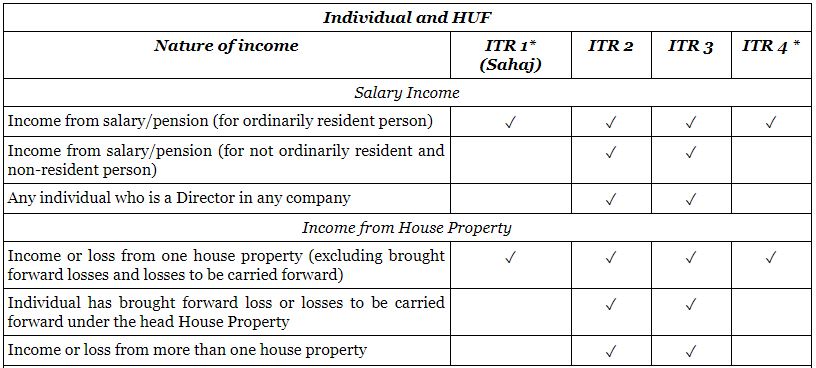
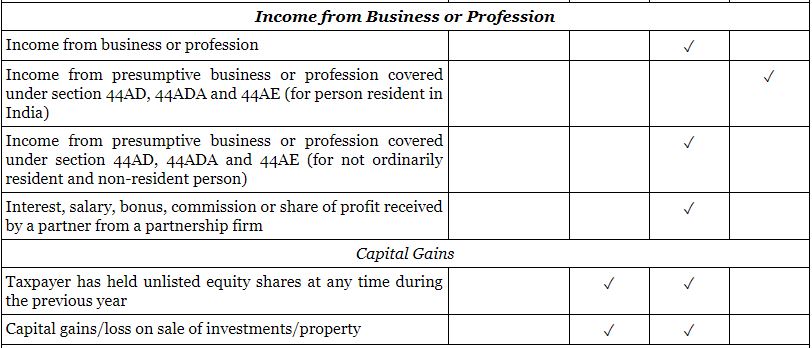
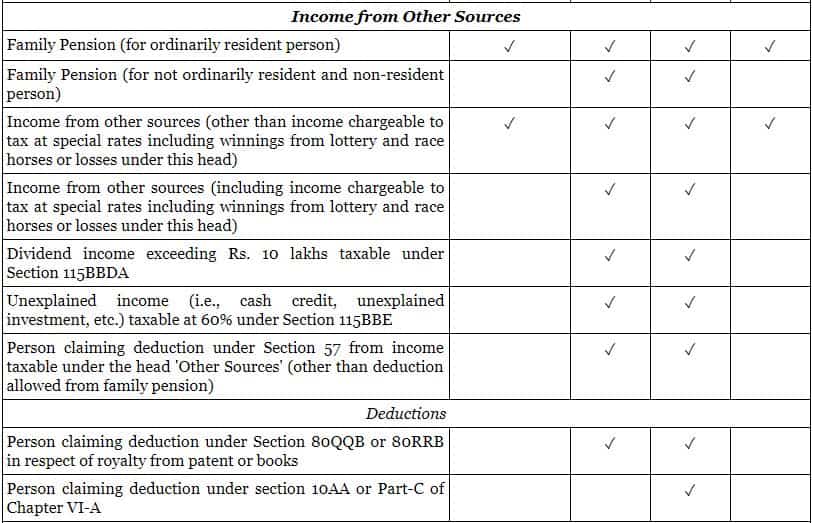



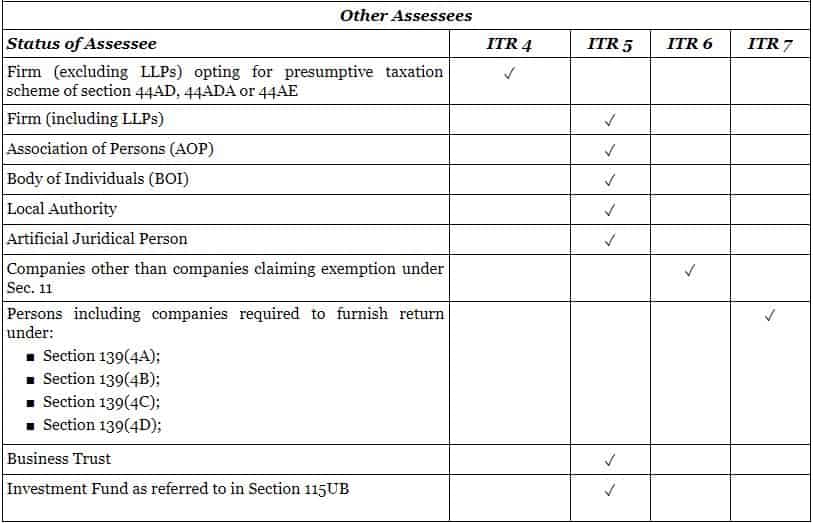
Business Income Tax Return Filing Process:-
- Add service to cart
- Click on view cart
- Apply coupon (if have any)
- Proceed to checkout
- Fill the information & pay the amount.
- After receiving payment our executive will mail & call you to provide documents.
- After receiving necessary documents, our professional team will calculate the tax.
- We will inform you to pay the tax.
- After payment of tax, we will finish the work & forward you ITR Acknowledgement & ITR Form.
OR
You can call our team on below number to start or know about the Business Income Tax Return Filing or any other services.
Mobile No – 8810627935, 8802444969
Email – info@infinitycompliance.in
Sorry!!!
Currently No Offer Available
Please check back later…
Or
Call our executive to get one
8810627935, 8802444969
Frequently Asked Questions:-
It is a tax levied by the Government of India on the income of every person. The provisions governing the Income-tax are covered in the Income-tax Act, 1961.
Income-tax is levied on the annual income of a person. The year under the Income-tax Law is the period starting from 1st April and ending on 31stMarch of next calendar year. The Income-tax Law classifies the year as (1) Previous year, and (2) Assessment year.
The year in which income is earned is called as previous year and the year in which the income is charged to tax is called as assessment year.
e.g., Income earned during the period of 1st April, 2019 to 31st March, 2020 is treated as income of the previous year 2019-20. Income of the previous year 2019-20 will be charged to tax in the next year, i.e., in the assessment year 2020-21.
Allowances are fixed periodic amounts, apart from salary, which are paid by an employer for the purpose of meeting some particular requirements of the employee. E.g., Tiffin allowance, transport allowance, uniform allowance, etc.
There are generally three types of allowances for the purpose of Income-tax Act – taxable allowances, fully exempted allowances and partially exempted allowances.
Perquisites are benefits received by a person as a result of his/her official position and are over and above the salary or wages. These fringe benefits or perquisites can be taxable or non-taxable depending upon their nature. . Uniform allowance is exempt to the extent of expenditure incurred for official purposes u/s 10(14).
An exempt income is not charged to tax, i.e., Income-tax Law specifically grants exemption from tax to such income. Incomes which are chargeable to tax are called as taxable incomes.
The presumptive taxation scheme of section 44AD can be adopted by following persons :
1) Resident Individual
2) Resident Hindu Undivided Family
3) Resident Partnership Firm (not Limited Liability Partnership Firm)
In other words, the scheme cannot be adopted by a non-resident and by any person other than an individual, a HUF or a partnership firm (not Limited Liability Partnership Firm).
Further, this Scheme cannot be adopted by a person who has made any claim towards deductions under section 10A/10AA/10B/10BA or under sections 80HH to80RRB in the relevant year.
ITR-4 or Sugam Form or Business Income Tax Return is for the taxpayers who have selected for the presumptive scheme of income as per Income Tax Act’s Section 44AD, Section 44ADA and Section 44AE. However, if the turnover of the business mentioned above exceeds Rs 2 crores, the taxpayer will have to file ITR-3.
Income-tax is to be paid by every person. The term ‘person’ as defined under the Income-tax Act under section 2(3) covers in its ambit natural as well as artificial persons.
For the purpose of charging Income-tax, the term ‘person’ includes Individual, Hindu Undivided Families [HUFs], Association of Persons [AOPs], Body of individuals [BOIs], Firms, LLPs, Companies, Local authority and any artificial juridical person not covered under any of the above.
Thus, from the definition of the term ‘person’ it can be observed that, apart from a natural person, i.e., an individual, any sort of artificial entity will also be liable to pay Income-tax.
Form ITR – 4 (SUGAM) can be used by an Individual/HUF/Firm (Other than LLP) whose total income for the year includes:
- Business income computed as per the provisions of section 44AD or 44AE; or;
- Income from Profession as computed as per the provisions of44ADA; or
- Income from salary/pension; or
- Income from one house property (excluding cases where loss is brought forward from previous years); or
- Income from other sources (excluding winnings from lottery and income from race horses dividend income in excess of Rs. 10 lakhs or unexplained Income, etc. as referred to in section 115BBE)
Further, in a case where the income of another person like spouse, minor child, etc., is to be clubbed with the income of the taxpayer, this return form can be used where income to be clubbed falls in any of the above categories.
Total Income is the income on which tax liability is determined. It is necessary to compute total income to ascertain tax liability .Section 80C to 80U provides certain deductions which can be claimed from Gross Total Income (GTI). After claiming these deductions from GTI, the income remaining is called as Total Income. In other words, GTI less Deductions (under section 80C to 80U) = Total Income (TI). Total income can also be understood as taxable income. Following table gives a better understanding of the difference between GTI and TI :
Computation of gross total income and Taxable Income
| Particulars | Amount |
| Income from salary | XXXXX |
| Income from house property | XXXXX |
| Profits and gains of business or profession | XXXXX |
| Capital gains | XXXXX |
| Income from other sources | XXXXX |
| Gross Total Income | XXXXX |
| Less : Deductions under Chapter VI-A (i.e. under section 80C to 80U) | (XXXXX) |
| Total Income (i.e., taxable income) | XXXXX |
Note : Inter source losses, inter head losses, brought forward losses, unabsorbed depreciation, etc., (if any) will have to be adjusted (as per the Income-tax Law) while computing the gross total income.
The presumptive taxation scheme of section 44AD can be opted by the eligible persons if the total turnover or gross receipts from the business do not exceed the limit prescribed under section 44AB (i.e., Rs. 2,00,00,000). In other words, if the total turnover or gross receipt of the business exceeds Rs. 2,00,00,000 then the scheme of section 44AD cannot be adopted.


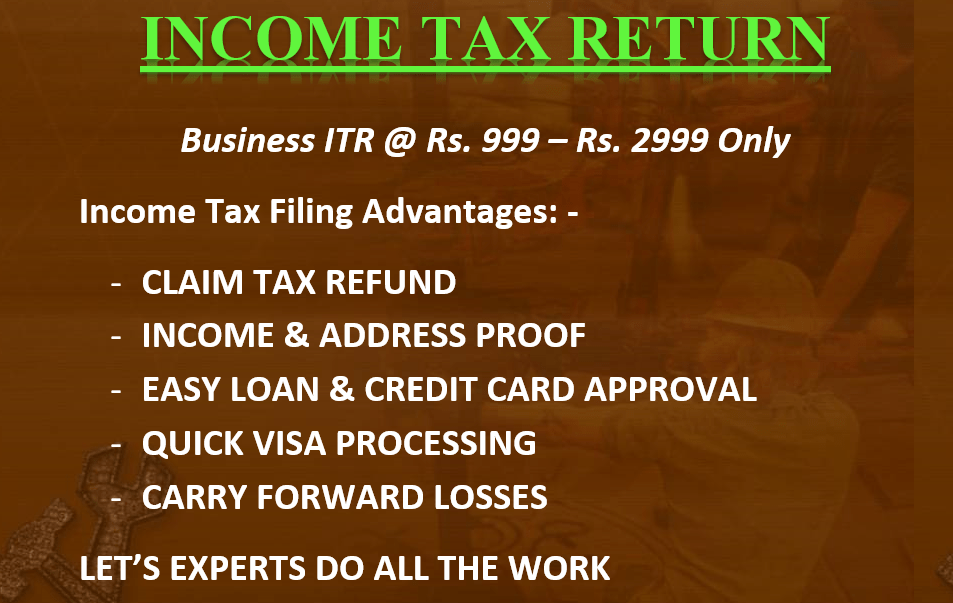
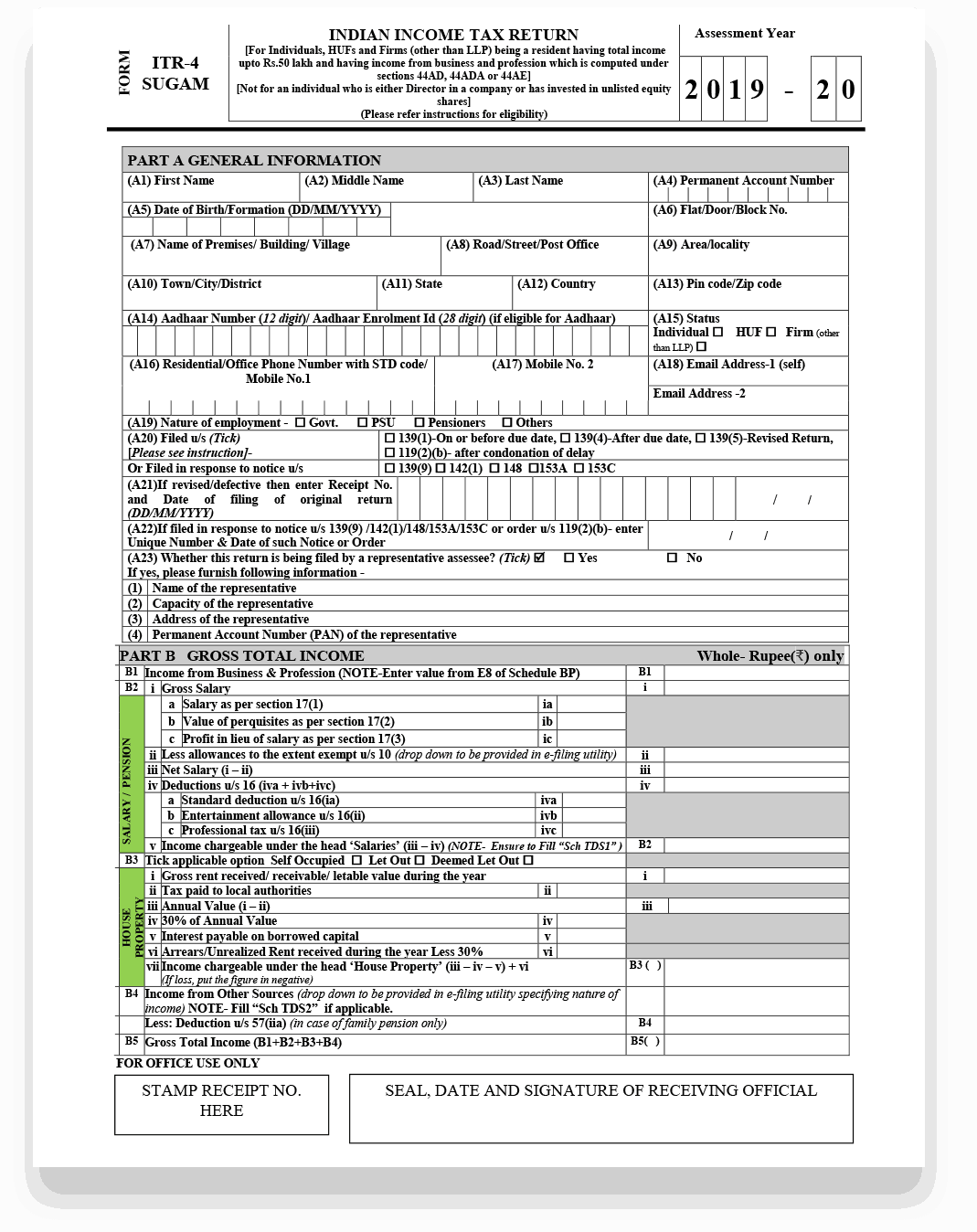
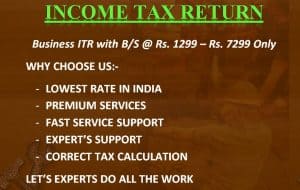
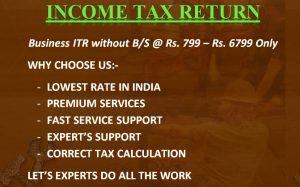
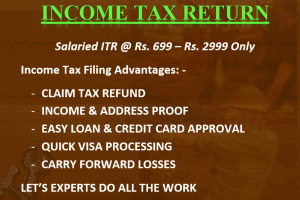
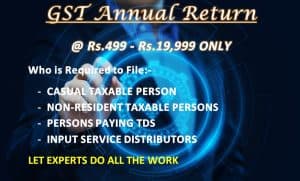

Reviews
There are no reviews yet.